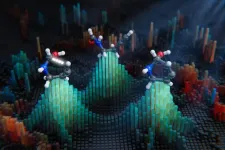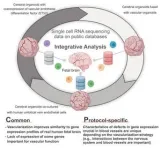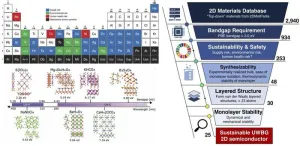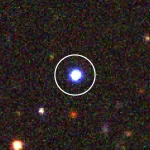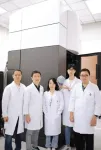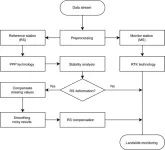(Press-News.org) CAMBRIDGE, MA — During a chemical reaction, molecules gain energy until they reach what’s known as the transition state — a point of no return from which the reaction must proceed. This state is so fleeting that it’s nearly impossible to observe it experimentally.
The structures of these transition states can be calculated using techniques based on quantum chemistry, but that process is extremely time-consuming. A team of MIT researchers has now developed an alternative approach, based on machine learning, that can calculate these structures much more quickly — within a few seconds.
Their new model could be used to help chemists design new reactions and catalysts to generate useful products like fuels or drugs, or to model naturally occurring chemical reactions such as those that might have helped to drive the evolution of life on Earth.
“Knowing that transition state structure is really important as a starting point for thinking about designing catalysts or understanding how natural systems enact certain transformations,” says Heather Kulik, an associate professor of chemistry and chemical engineering at MIT, and the senior author of the study.
Chenru Duan PhD ’22 is the lead author of a paper describing the work, which appears today in Nature Computational Science. Cornell University graduate student Yuanqi Du and MIT graduate student Haojun Jia are also authors of the paper.
Fleeting transitions
For any given chemical reaction to occur, it must go through a transition state, which takes place when it reaches the energy threshold needed for the reaction to proceed. The probability of any chemical reaction occurring is partly determined by how likely it is that the transition state will form.
“The transition state helps to determine the likelihood of a chemical transformation happening. If we have a lot of something that we don’t want, like carbon dioxide, and we’d like to convert it to a useful fuel like methanol, the transition state and how favorable that is determines how likely we are to get from the reactant to the product,” Kulik says.
Chemists can calculate transition states using a quantum chemistry method known as density functional theory. However, this method requires a huge amount of computing power and can take many hours or even days to calculate just one transition state.
Recently, some researchers have tried to use machine-learning models to discover transition state structures. However, models developed so far require considering two reactants as a single entity in which the reactants maintain the same orientation with respect to each other. Any other possible orientations must be modeled as separate reactions, which adds to the computation time.
“If the reactant molecules are rotated, then in principle, before and after this rotation they can still undergo the same chemical reaction. But in the traditional machine-learning approach, the model will see these as two different reactions. That makes the machine-learning training much harder, as well as less accurate,” Duan says.
The MIT team developed a new computational approach that allowed them to represent two reactants in any arbitrary orientation with respect to each other, using a type of model known as a diffusion model, which can learn which types of processes are most likely to generate a particular outcome. As training data for their model, the researchers used structures of reactants, products, and transition states that had been calculated using quantum computation methods, for 9,000 different chemical reactions.
“Once the model learns the underlying distribution of how these three structures coexist, we can give it new reactants and products, and it will try to generate a transition state structure that pairs with those reactants and products,” Duan says.
The researchers tested their model on about 1,000 reactions that it hadn’t seen before, asking it to generate 40 possible solutions for each transition state. They then used a “confidence model” to predict which states were the most likely to occur. These solutions were accurate to within 0.08 angstroms (one hundred-millionth of a centimeter) when compared to transition state structures generated using quantum techniques. The entire computational process takes just a few seconds for each reaction.
“You can imagine that really scales to thinking about generating thousands of transition states in the time that it would normally take you to generate just a handful with the conventional method,” Kulik says.
Modeling reactions
Although the researchers trained their model primarily on reactions involving compounds with a relatively small number of atoms — up to 23 atoms for the entire system — they found that it could also make accurate predictions for reactions involving larger molecules.
“Even if you look at bigger systems or systems catalyzed by enzymes, you’re getting pretty good coverage of the different types of ways that atoms are most likely to rearrange,” Kulik says.
The researchers now plan to expand their model to incorporate other components such as catalysts, which could help them investigate how much a particular catalyst would speed up a reaction. This could be useful for developing new processes for generating pharmaceuticals, fuels, or other useful compounds, especially when the synthesis involves many chemical steps.
“Traditionally all of these calculations are performed with quantum chemistry, and now we're able to replace the quantum chemistry part with this fast generative model,” Duan says.
Another potential application for this kind of model is exploring the interactions that might occur between gases found on other planets, or to model the simple reactions that may have occurred during the early evolution of life on Earth, the researchers say.
###
The research was funded by the U.S. Office of Naval Research and the National Science Foundation.
END
Computational model captures the elusive transition states of chemical reactions
Using generative AI, MIT chemists created a model that can predict the structures formed when a chemical reaction reaches its point of no return
2023-12-15
ELSE PRESS RELEASES FROM THIS DATE:
Parents underestimate the importance of guided play in education, finds US study
2023-12-15
Child psychologists have long known that play is essential for children’s cognitive development because it boosts their social, physical, and emotional skills. But beginning in the 21st century, specialists repeatedly sounded the alarm that ‘play is under siege’ for US children. Kids were playing less, and – it was feared – with a lesser quality.
But are today’s parents sufficiently aware of the importance of letting their children play? Yes, found a team of researchers who tested this through a survey of the opinions of 1,172 US parents. Their results showed that today’s ...
Responsible stewardship over ultrathin materials research
2023-12-15
To an everyday consumer, the best gadgets on the market have the highest speed, the largest memory, and the longest battery life. Chasing this demand, the forefront of research often only considers these tangible performance metrics when innovating and designing next-generation electronics. In the wake of this technological stampede, the long-term environmental impacts lie obscured and neglected under the dust.
Researchers at the Singapore University of Technology and Design (SUTD) hope to be the catalyst for sustainability-driven science. Assistant Professor Ang Yee Sin from the Science, Mathematics ...
Large sequence models for sequential decision-making
2023-12-15
Transformer architectures have facilitated the development of large-scale and general-purpose sequence models for prediction tasks in natural language processing and computer vision, e.g., GPT-3 and Swin Transformer. Although originally designed for prediction problems, it is natural to inquire about their suitability in another important field, sequential decision-making and reinforcement learning problems, which are typically beset by long-standing issues involving sample efficiency, credit assignment, and partial observability, etc. In recent years, sequence models, especially the Transformer, have attracted increasing interest in the RL communities, spawning ...
New red galaxies turn out to be already known blue galaxies
2023-12-15
Not all discoveries turn out to be actual new discoveries. This was the case for the extremely red objects (EROs) found in James Webb Space Telescope (JWST) data. Analysis shows that they are very similar to blue-excess dust obscured galaxies (BluDOGs) already reported in Subaru Telescope data.
Quasars, some of the brightest objects in the Universe, are driven by a supermassive black hole with a mass that can reach more than a billion times that of the Sun. These objects are the focus of much research, but how ...
HKUST researchers report the high-res structure of a cyanobacterial virus
2023-12-15
A research team at the Hong Kong University of Science and Technology (HKUST) has outlined the high-resolution structure of a little-known virus, improving our understanding of viral infection, which could pave the way for more accurate predictions of climate change.
With the help of an advanced technique involving cryo-electron microscopy, they managed to capture images of the virus – the cyanophage P-SCSP1u – at near-atomic resolution in its native form and examined it to see how its different parts fit together. This helped show how different proteins work in the virus and how they interact to make the virus ...
Advanced GNSS technique enhances accuracy in landslide monitoring
2023-12-15
In a new study published on 13 November 2023, in the journal Satellite Navigation, researchers from Chang’an University have developed a novel approach using the Precise Point Positioning (PPP) technique combined with a cumulative sum control chart (CUSUM) method. This method enables the analysis of reference station stability and compensates for deformation at monitoring stations.
In the study conducted at the Tengqing landslide in Liupanshui, Guizhou Province, Southwest China, an innovative method was applied, showcasing a significant leap in landslide monitoring using GNSS PPP technology. ...
Risk of death reduces after COVID-19 vaccine but protection wanes after six months – study
2023-12-15
The risk of death from COVID-19 decreases significantly after vaccination but this protection diminishes after six months, providing evidence for continued booster doses, a new study has found.
Researchers from the UK Health Security Agency (UKHSA) analysed more than 10 million cases of COVID-19 in adults between May 2020 and February 2022. Their findings are published in the Journal of the Royal Society of Medicine (JRSM).
The Case Fatality Risk (CFR) - the proportion of cases that resulted in death - was cross-referenced with vaccination ...
The breakthrough is a step towards the development of next-generation magnetic devices that control light
2023-12-15
In a significant advancement in optical technology, researchers from Tohoku University and Toyohashi University of Technology have developed a new method for creating transparent magnetic materials using laser heating. This breakthrough, recently published in the journal Optical Materials, presents a novel approach to integrating magneto-optical materials with optical devices, a long-standing challenge in the field.
"The key to this achievement lies in creating 'Cerium-substituted Yttrium Iron Garnet (Ce:YIG)', ...
How an overlooked study over a century ago helped fuel the Colorado River crisis
2023-12-15
When it comes to the Colorado River, history often repeats itself—but it doesn’t have to.
That’s the take-home message from CU Boulder hydrologist Shemin Ge, who will present a little-known piece of history from the river this Thursday at the American Geophysical Union (AGU) meeting in San Francisco.
The story of hydrologist Eugene Clyde La Rue, Ge said, may help to explain the current water crisis facing many states in the American West.
Ge’s presentation centers around a decision ...
Basic monthly income trial at USC shows promise with significant reduction in homelessness
2023-12-15
Researchers at the Center for Homelessness, Housing, and Health Equity Research at the University of Southern California released an interim report on the first six months of a randomized controlled trial to study the impact of a basic income and social support intervention for 103 individuals experiencing homelessness in Los Angeles County and the San Francisco Bay Area.
Two key findings so far are that participants in the Miracle Money study who received $750 per month were less likely to remain unsheltered and closer ...
LAST 30 PRESS RELEASES:
Scientists trace microplastics in fertilizer from fields to the beach
The Lancet Obstetrics, Gynecology, & Women’s Health: Taking paracetamol during pregnancy does not increase risk of autism, ADHD or intellectual disabilities, confirms new gold-standard evidence review
Taking paracetamol during pregnancy does not increase risk of autism, ADHD or intellectual disabilities
Harm reduction vending machines in New York State expand access to overdose treatment and drug test strips, UB studies confirm
University of Phoenix releases white paper on Credit for Prior Learning as a catalyst for internal mobility and retention
Canada losing track of salmon health as climate and industrial threats mount
Molecular sieve-confined Pt-FeOx catalysts achieve highly efficient reversible hydrogen cycle of methylcyclohexane-toluene
Investment in farm productivity tools key to reducing greenhouse gas
New review highlights electrochemical pathways to recover uranium from wastewater and seawater
Hidden pollutants in shale gas development raise environmental concerns, new review finds
Discarded cigarette butts transformed into high performance energy storage materials
Researchers highlight role of alternative RNA splicing in schizophrenia
NTU Singapore scientists find new way to disarm antibiotic-resistant bacteria and restore healing in chronic wounds
Research suggests nationwide racial bias in media reporting on gun violence
Revealing the cell’s nanocourier at work
Health impacts of nursing home staffing
Public views about opioid overdose and people with opioid use disorder
Age-related changes in sperm DNA may play a role in autism risk
Ambitious model fails to explain near-death experiences, experts say
Multifaceted effects of inward foreign direct investment on new venture creation
Exploring mutations that spontaneously switch on a key brain cell receptor
Two-step genome editing enables the creation of full-length humanized mouse models
Pusan National University researchers develop light-activated tissue adhesive patch for rapid, watertight neurosurgical sealing
Study finds so-called super agers tend to have at least two key genetic advantages
Brain stimulation device cleared for ADHD in the US is overall safe but ineffective
Scientists discover natural ‘brake’ that could stop harmful inflammation
Tougher solid electrolyte advances long-sought lithium metal batteries
Experts provide policy roadmap to reduce dementia risk
New 3D imaging system could address limitations of MRI, CT and ultrasound
First-in-human drug trial lowers high blood fats
[Press-News.org] Computational model captures the elusive transition states of chemical reactionsUsing generative AI, MIT chemists created a model that can predict the structures formed when a chemical reaction reaches its point of no return
